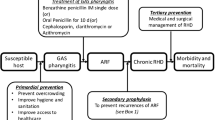Abstract
Haemolytic-uraemic syndrome (HUS) associated withAeromonas hydrophila enterocolitis is reported in a 23-month-old female infant. TheA. hydrophila strain isolated from the patient's stool sample produced cytotoxin against verocells; increasing levels of cytotoxinneutralizing antibody in the patient's sera were demonstrated, suggesting a recent infection. This report indicates thatA. hydrophila should be suspected as a possible cause of HUS, and that this pathogen should be looked for in cases of post-diarrhoeal HUS.
Similar content being viewed by others
References
Fong JSC, Chadarevian JP de, Kaplan BS (1982) Hemolytic-uremic syndrome: current concepts and management. Pediatr Clin North Am 29:35–56
Drummond KN (1985) Hemolytic-uremic syndrome — then and now. N Engl J Med 312:116–118
Cleary TG (1988) Cytotoxin-producingEscherichia coli and the hemolytic-uremic syndrome. Pediatr Clin North Am 35:485–501
Levin M, Walters MDS, Barratt TM (1989) Hemolytic uremic syndrome. Adv Pediatr Infect Dis 4:51–82
Karmali MA, Petric M, Lim C, Fleming PC, Arbus GS, Lior H (1985) The association between idiopathic hemolytic-uremic syndrome and infection by verotoxin-producingEscherichia coli. J Infect Dis 151:775–782
Karmali MA (1989) Infection by verocytotoxin-producingEscherichia coli. Clin Microbiol Rev 2:15–38
Edelman R, Karmali MA (1988) Summary of the international symposium and workshop on infections due to verocytotoxin (shiga-like toxin) — producingEscherichia coli. J Infect Dis 157:1102–1104
Neill MA, Tarr PI, Clausen CR, Christie DL, Hickman RO (1987)Escherichia coli 0157∶H7 as the predominant pathogen associated with the hemolytic-uremic syndrome: a prospective study in the Pacific Northwest. Pediatrics 30:17–40
Habib R, Levy M, Gagnadoux MF, Broyer M (1982) Prognosis of the hemolytic uremic syndrome in children. Adv Nephrol 11: 99–128
Karmali MA (1987) Laboratory diagnosis of verotoxin-producingEscherichia coli infections. Clin Microbiol Newsl 9:65–70
Gracey M, Burke V, Robinson J (1982) Aeromonas-associated gastroenteritis. Lancet II:1304–1306
Agger WA, McCormick JD, Gurwith MJ (1985) Clinical and microbiologial features ofAeromonas hydrophila-associated diarrhea. J Clin Microbiol 21:909–913
Kindschuh M, Pickering LK, Cleary TG, Ruiz-Palacios G (1987) Clinical and biochemical significance of toxin production byAeromonas hydrophila. J Clin Microbiol 25:916–921
Altwegg M, Geiss HK (1989) Aeromonas as a human pathogen. CRC Crit Rev Microbiol 16:253–286
Nazar H, Price EH, Hunt GH, Walker-Smith JA (1986) Clinical associations ofAeromonas spp. in fecal specimens from children. Clin Pediatr (Phila) 25:516–519
San Joaquin VH, Pickett DA (1988) Aeromonas-associated gastroenteritis in children. Pediatr Infect Dis J 7:53–57
Challapalli M, Tess BR, Cunningham DG, Chopra AK, Houston CW (1988) Aeromonas-associated diarrhea in children. Pediatr Infect Dis J 7:693–698
Fumarola D, Miragliotta G (1986) More on pathogenic mechanisms of Aeromonas-related diarrhea (letter). Pediatr Infect Dis J 5:607
Rose JM, Houston CW, Coppenhaver DH, Dixon JD, Kurosky A (1989) Purification and chemical characterization of a cholera-toxincross-reactive cytolytic enterotoxin produced by a human isolate ofAeromonas hydrophila. Infect Immun 57:1165–1169
Rose JM, Houston CW, Kurosky A (1989) Bioactivity and immunological characterization of a cholera toxin-cross-reactive cytolytic enterotoxin fromAeromonas hydrophila. Infect Immun 57: 1170–1176
Richardson SE, Karmali MA, Becker LE, Smith CR (1988) The histopathology of the hemolytic-uremic syndrome associated with verocytotoxin-producingEscherichia coli infections. Hum Pathol 19:1102–1108
Kavi J, Wise R (1989) Causes of the haemolytic uremic syndrome Br Med J 289:65–66
Kaplan BS, Cleary TG, Obrig TG (1990) Recent advances in understanding the pathogenesis of the hemolytic uremic syndromes. Pediatr Nephrol 4: 276–283
Obrig TG, Del Vecchio PJ, Karmali M, Petric M, Moran TP, Judge TK (1987) Pathogenesis of hemolytic uremic syndrome. Lancet II: 687
Howard SP, Buckley JT (1982) Membrane glycoprotein receptor and a hole-forming properties of a cytolytic protein. Biochemistry 21: 1662–1667
Kozaki S, Kato K, Asao T, Kamata Y, Sakagushi G (1987) Activities ofAeromonas hydrophila hemolysins and their interaction with erythrocyte membranes Infect Immun 55: 1594–1599
Cybulsky MI, Chan MKW, Movat HZ (1988) Acute inflammation and microthrombosis induced by endotoxin, IL-1, and TNF and their implication in gram-negative infection. Lab Invest 58: 365–378
Author information
Authors and Affiliations
Rights and permissions
About this article
Cite this article
Bogdanović, R., Čobeljić, M., Marković, M. et al. Haemolytic-uraemic syndrome associated withAeromonas hydrophila enterocolitis. Pediatr Nephrol 5, 293–295 (1991). https://doi.org/10.1007/BF00867480
Received:
Revised:
Accepted:
Issue Date:
DOI: https://doi.org/10.1007/BF00867480




